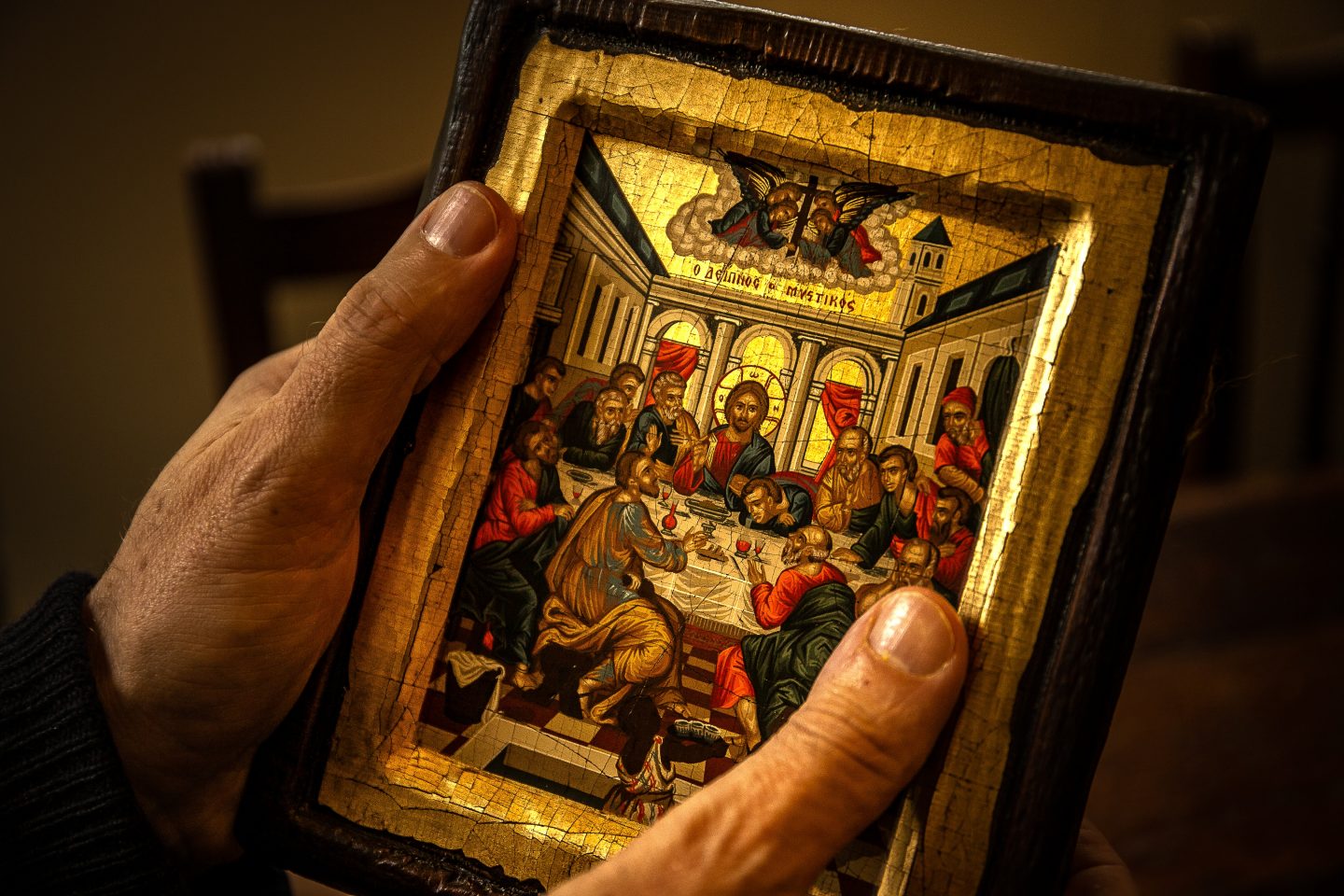
Photo by James Coleman on Unsplash.
Our worldview is affected by and will affect our engagement with the arts, whether that’s poetry, visual arts, performing arts, architecture or any other kind of art.
If it’s good art, it’ll be wrestling with the reality of our human engagement, and both the highs and the lows of what it means to be a human in the world today.
Creative because of a creative God
Art flows from the fact that human beings are themselves essentially creative.
From a Christian worldview, that is part of what is known as the imago dei, the image of God.
Being a visionary leader is imagining a scenario that does not yet exist and creatively working out the steps to get there.
Human beings are made in the image of God. And therefore if God is a creative God, humanity is essentially creative.
Some people have the idea that somehow art is a luxury or an add-on. Once you’ve got everything else covered, you have your space to explore other things.
But that’s not a good way of understanding culture. It’s also a very bad way of understanding humans, as it has a reducing and damaging effect upon us.
What often happens is, as the years go by, you feel that you are less and less yourself. You are being reduced and squeezed into a box.
I’ve met many a creative mathematician, as they start to imagine their way out of a problem.
Being a visionary leader is having to imagine a scenario that does not yet exist and then creatively work out the paths and the steps to get to that place.
Art in the Bible
The Bible goes slightly further than that, I believe, in affirming creativity.
From the beginning of Exodus (Exodus 31:1-6), the first people who were described in the Bible as being filled with the Holy Spirit are two artists, Bezalel and Oholiab, who are described a couple of times in Exodus as being filled with the Holy Spirit and gifted with all kinds of artistic work and the ability to teach artistry.
If they can’t express themselves, they can’t find healing and they can’t find their humanity.
And later on, the strong singing culture of the art was embedded into Hebrew narrative. One of the symptoms of great heartache and of great trouble is that they lost their capacity to sing. And so what you see here in Psalm 137:1-9 is that they have been traumatised by being taken into exile.
Ironically, a song emerges about the inability to sing songs.
Even when they’ve lost everything, they’re still singing. The art is how they express themselves. And if they can’t express themselves, they can’t find healing and they can’t find their humanity.
Their ability to express themselves, through poetry and through song, allowed them to go through some of the most traumatic things that was possible for a community to go through.
Jacob’s ladder
I’d like to take us all on a bit of a thought experiment around a very famous passage in Genesis. It’s known as Jacob’s dream or Jacob’s ladder (Genesis 28:10-15).
He lies down to sleep on stony ground and says he has a stone for a pillow at night. In the middle of the night he has a dream. In this dream, a couple of things happen.
Their ability to express themselves, through poetry and song, allowed them to go through some of the most traumatic things.
One is, at the very place where he’s resting his head, just in the middle of the desert with a stone for a pillow, something like a stairway or a ladder opens up between earth and heaven.
And the Bible says that the angels are running up and down in both directions. There’s this sense of the gap between heaven and earth being very thin in this dream.
And it’s just a ladder, just a stairway is all that it takes to get from God to humanity.
The passage also says that God starts to speak to him, and tells him that there’s a purpose and a plan for his life.
Now one of the things that the arts can be very good at is expressing some of these deep, visionary moments, and applying them to our lives.
What does stony ground look like? There’s nowhere for Jacob to lay his head besides a stone for a pillow. We, too, have this kind of “stony” existence.
Our culture is very good at exploring futility and meaninglessness of life.
TS Elliot’s poem:
“For I have known them all already, known them all.
I have known the evenings, mornings, afternoons,
I have measured out my life with coffee spoons;
I know the voices dying with a dying fall,
Beneath the music from a farther room. So how should I presume?”
This is a deep part of what it means to be human, that we are born with a desire for home, but we are wrestling with the reality of homelessness.
Other artists over the years have actively engaged with this Jacob’s ladder image, to explore the reality of living in stony ground but having a longing for heaven.
Damien Hirst says he was struggling through much of his art, with believing that we have no future in eternity.
He said: “I have a longing for eternity but I’ve been told it doesn’t exist. But I can’t escape that fact. I won’t let go of that desire.”
He explores this in pretty much of all of his conceptual art.
Art points to the cross
And this starts to bring us to the cross.
Yes, though we get pictures of Jacob’s ladder, of this stony ground and a longing for God, the cross and the resurrection is the fundamental place at which these artistic and human and divine themes collide.
It’s one of the reasons that the cross is explored again and again.
That’s what the cross was – a form of Jacob’s ladder, where God came down from heaven to speak to humanity.
There is one human being who has influenced culture more than any other person, which is the person of Jesus Christ.
It’s impossible to be a good historian of the arts without properly contemplating who Jesus Christ is.
The reality of the fact that we have this longing for home is because we are meant for home.
Some art theorists go so far as to say it’s not possible to understand western art at all without understanding the person of Christ. And there was nearly no commissioned art until the 1700s that wasn’t framed in and around Christ.
The reality of the fact that we have a longing for home is because we are meant for home.
How does the cross answer that inner sense of alienation inside us?
Sometimes wishing something to be so, doesn’t make it happen. You can’t escape reality.
Aldous Huxley was one of the honest atheists of the 1940s and 50s, who said that he wanted God not to exist, so that he could do whatever he wanted. He didn’t want there to be an eternal referral outside of himself.
Often, people imagine that the belief in God is a kind of psychological projection but, as CS Lewis demonstrated, atheism can also be a psychological projection for wanting God not to exist.
And in a sense, that’s what the younger son does in the parable of the prodigal son (Luke 15:11-32). He wants the father not to exist. But not wanting the father to exist doesn’t mean the father doesn’t exist. The father still exists and still wants to have a relationship with his son.
And there you have within it, the beginnings of the theology of the cross and the theology of grace.
The modern British artist, Charlie Mackesy, has explored this in a lot of depth. This is how he retells it in his paintings: “This is the story of the prodigal son. It should really be called the running father who waited every day for his boy to come home – the son who had rejected him so badly. But when he saw him from afar, he ran to him, hugged him and kissed him.”
The cross of Jesus Christ, whether it’s explored in art, in theology, in faith, or in worship, is a homecoming.
And so I hope I’ve taken us on a little bit of a journey from that sense of Jacob on stony ground feeling far from home, and how artists have explored the reality of the stoniness of human existence.
In the heart of every human being is creativity, but within that creativity, there is also a longing for home. The reality of the fact that we have this longing for home is because we are meant for home.
Our homesickness only makes sense if there was a home to be sick for.
And it is possible for a loving father to run and bring people back home again.
The cross of Jesus Christ, whether it’s explored in art, in theology, in faith, or in worship, is a homecoming.
It’s a Jacob’s ladder where God bridges the gap between heaven and earth and speaks intimately to anybody who is lying down on stony ground, feeling far from home.
This article is adapted from Dr Francis Orr-Ewing’s talk, “Art and Faith”, at the Festival of Thought 2019, held in the Faith Community Baptist Church (Marine Parade) on April 4. Festival of Thought was organised by RZIM Zacharias Trust.
We are an independent, non-profit organisation that relies on the generosity of our readers, such as yourself, to continue serving the kingdom. Every dollar donated goes directly back into our editorial coverage.
Would you consider partnering with us in our kingdom work by supporting us financially, either as a one-off donation, or a recurring pledge?
Support Salt&Light




